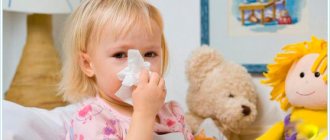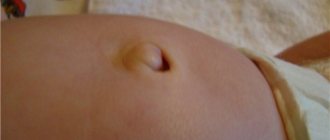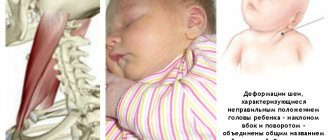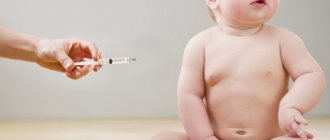Such a fairly common disease as laryngitis in infants is an inflammation of the laryngeal mucosa. Often this disease manifests itself in children, sometimes in infants, which is primarily associated with low immunity, complications after a cold, or a viral or bacterial infection. Laryngitis in children under one year of age is quite common, so it is worth knowing how to recognize it and how to deal with attacks.
If we are talking about an adult, then laryngitis is not a serious disease for him; it is quite simple to treat.
As for children, this is one of the most dangerous diseases, which threatens with quite serious consequences and complications if it is not treated, especially if laryngitis develops in children under one year old.
To prevent all possible complications, it is worth knowing what this disease may be associated with, what symptoms accompany the onset of the disease, and what actions parents should take to relieve the attack and begin effective treatment.
Why is laryngitis dangerous for babies?
In the infectious form of the disease, characteristic complications are inflammatory processes in other parts of the respiratory tract, which include bronchitis and pneumonia.
The most common complication of laryngitis occurring in infants is croup. This is a respiratory pathology that occurs when there is a significant narrowing of the laryngeal lumen. As a rule, symptoms of complications appear at night. It becomes difficult for the child to breathe, and unusual whistling sounds are made during inhalations and exhalations.
In some cases, the complication is characterized by blueness of the skin, which indicates insufficient oxygen saturation of the blood. The main cause of croup is an inflammatory process occurring in the larynx. The narrowest place in this department is the subglottic space, which narrows so much that it causes disruption of the breathing process.
The nocturnal manifestation of croup is caused by the accumulation of mucus in the lumen of the larynx, which dries out due to insufficient supply of salivary fluid, thereby causing difficulty in respiratory function. If we look at the statistics, a complication occurs in every 2 newborns. When it appears, it is recommended to immediately call a doctor.
Call an ambulance immediately if you have the following symptoms:
- wheezing;
- lack of air when breathing, difficulty swallowing;
- increased production of salivary fluid;
- hoarseness of voice;
- blueness, paleness of the skin;
- retraction of the skin in the intercostal spaces during inspiration.
Such symptoms also indicate the presence of edema of the epiglottis, tracheitis, but only a doctor can make an accurate diagnosis.
Symptoms
The initial stage is manifested by unpleasant sensations of burning and dryness in the larynx, although the general condition is not bad. At the next stage, a convulsive and exhausting cough, headache, and difficulty swallowing appear. The hoarse voice disappears, turning into a whisper.
The cough becomes wet, with expectoration of sputum, sometimes purulent. The level of blood leukocytes increases. The mucous membrane of the larynx turns sharply red and swells, and purple dots appear on it due to burst capillaries.
Types of disease
In medicine, there is a division of laryngitis into several types depending on the form of development and severity of clinical manifestations. According to the form, the disease is divided into:
- Catarrhal. This type of laryngitis occurs in most cases. Clinical manifestations are similar to symptoms of other infectious pathologies. These are a dry cough, a slight increase in temperature, and hoarseness. Despite the smoothed course of the disease, it requires immediate treatment, as it can be complicated by respiratory failure.
- Stenotic. This form of the disease occurs with nocturnal croup, that is, a pronounced decrease in the laryngeal lumen.
- Hypertrophic. It may be of primary origin or occur as a complication of catarrhal laryngitis. Hoarseness or temporary loss of voice is observed.
- Atrophic. In most cases, such laryngitis occurs in adults, however, cases of the disease in infants are no exception. Based on the diagnostic results, thinning of the mucous membranes in the larynx is revealed.
- Hemorrhagic. Laryngitis in this form often occurs against the background of toxic flu or disease of the hematopoietic organs. A dry cough occurs, and when it turns into a wet cough, bloody streaks appear in the sputum.
- Diphtheria. The development of the disease occurs in the tonsil-larynx direction. A white coating appears on the mucous membrane of the throat, which, when peeled off, clogs the airways.
- Phlegmous. This form of pathology is rarely diagnosed. Occurs as a complication of catarrhal laryngitis. It occurs with the formation of purulent plaque on the larynx.
Depending on the intensity of development, laryngitis is divided into acute and chronic. In the first case, clinical manifestations occur suddenly. The child is bothered by a severe cough, pain when swallowing, hoarseness of voice, which causes increased irritability, anxiety, and tearfulness. The vocal cords are hyperemic and swollen.
With chronic laryngitis, the course of the disease is slower. The reason for the chronicity of the process is the frequent acute development of pathology, which was treated incorrectly or not completely.
Physiotherapeutic procedures
How to treat laryngitis in children using inhalations? They have a good effect and can be used even by infants. You can make the procedure easier using a nebulizer. It has many advantages:
- temperature control, because hot steam can burn the mucous membrane and slow down the healing process;
- precise dosing of medications, which is especially important in the treatment of children;
- ease of inhalation;
- no need to synchronize breathing with the operation of the device.
The procedure has some features:
- it is carried out an hour after eating;
- after inhalation, you should not go out into the cold, eat or drink for half an hour;
- it is not performed for fever above 37.5 degrees;
- During inhalation it is forbidden to talk, you must breathe calmly;
- You cannot inhale oil and herbal solutions using a nebulizer;
- After the procedure, the device should be washed thoroughly to prevent contamination;
- The device is only allowed to use saline solution, which should be used to dilute the medicine to obtain a certain concentration.
The medicine for inhalation is selected taking into account allergic predisposition and the severity of the disease.
Using a nebulizer, you can inhale Interferon (an antiviral agent), still Borjomi mineral water, saline solution, Lazolvan, Rotokan, Sinupret and Tonsilgon. Inhalation allows you to moisturize the mucous membrane, reduce its irritation, facilitate coughing up sputum by dissolving sputum, and also reduce the severity of inflammation and swelling of the mucous membrane.
If several types of inhalations are prescribed, you must follow the order of use of medications depending on their effect:
- The first to be inhaled is a bronchodilator drug, for example, Ventolin or Berodual. It eliminates bronchospasm and facilitates the removal of sputum;
- then an expectorant is used, for example, Lazolvan or Fluimucil;
- the latter can be used anti-inflammatory (Rotocan, Sinupret) or antiseptic agents (Fluimucil antibiotic, Dekasan).
Inhalations in the usual way (over a saucepan) can be carried out with a decoction of calendula, coltsfoot, pine buds, chamomile and sage. You can also add a couple of drops of essential oil (tea tree, eucalyptus, cedar). Alkaline inhalation can be prepared by adding 5 g of soda to boiled potatoes.
Inhalation with Pulmicort is carried out when there is a threat of laryngospasm, as well as when it develops. This hormonal medicine can quickly reduce tissue swelling and make breathing easier.
For chronic cases, electrophoresis, ultraviolet exposure, UHF and microwave therapy are recommended.
In the absence of fever, warm foot baths can be used to increase blood flow to the legs and reduce swelling of the vocal cords and laryngeal mucosa. Rubbing the chest with animal fat or the medicine Doctor Mom. The procedure is performed for bronchitis, which develops as a complication of laryngitis. If there is a risk of croup, rubbing is prohibited.
Having overcome the disease, you should start strengthening your immune system. To do this, you can use homeopathic medicines, Multitabs vitamins, Supradin and non-drug remedies. Water procedures, proper nutrition and climate change are especially beneficial for children.
Source
Causes
Before prescribing effective treatment for laryngitis in a newborn or a child of a different age group, the doctor prescribes appropriate diagnostic measures, the results of which can identify the cause of the development of the pathology.
Among the sources of laryngitis are the following:
- acute respiratory infection and influenza;
- bacterial infection of the upper respiratory tract with pneumococci, staphylococci, streptococci, Haemophilus influenzae;
- history of scarlet fever or measles;
- inflammatory process in the paranasal sinuses;
- hypothermia (local or general);
- systematic exposure to smoky and cold conditions;
- congenital weakened immunity, low body resistance to infections;
- constant contact with an allergen (dust, pet hair, etc.);
- prolonged use of throat sprays, which cause a reflex spasm of the larynx;
- overstrain of the vocal cords during strong screaming or crying;
- development of an infectious disease in the oral cavity.
In most cases, the nature of the disease is diagnosed as viral rather than bacterial.
Is laryngitis contagious?
Laryngitis caused by infection is a contagious disease and is transmitted by airborne droplets, so it is better to limit the contact of healthy children with the sick person. It is especially dangerous for children under 4 years of age, as due to the larynx not fully formed, it provokes severe swelling that can lead to suffocation.
Allergic laryngitis is not transmitted to others, as its symptoms are caused by exposure to allergens: food, household and natural irritants, industrial pollution. Treatment of the disease in children under 2 years of age is carried out inpatiently.
Symptoms and signs of laryngitis in children
Only a doctor can make a correct diagnosis by examining the oropharynx and prescribing appropriate studies. It is impossible to determine the type of pathology by symptoms alone, since the newborn is not yet able to directly indicate disturbing manifestations. In addition, the clinical picture of laryngitis is similar to other diseases. Despite this, symptoms characteristic of the disease include:
- hoarseness: the development of the pathology is characterized by a narrowing of the laryngeal lumen, which provokes incomplete closure of the vocal cords and a change in voice timbre (hoarseness is clearly audible during crying or screaming);
- barking paroxysmal cough at the initial stage, the intensity of which increases in the evening and at night (the transition of a dry cough to a wet one means that the treatment was prescribed correctly);
- pain in the throat area, which varies in severity depending on the stage of development of the disease (the child reacts to such a symptom with anxiety and crying);
- increase in body temperature to low-grade levels (if the disease is viral, the temperature can increase to 39-40 degrees);
- a feeling of lack of air, which is caused by a narrowing of the laryngeal lumen and can cause respiratory failure;
- violation of the general condition: the child becomes capricious, does not suck the breast or eat formula well, and mobility decreases.
Based on the severity of clinical manifestations, the degree of damage to the respiratory tract is determined.
How long does it take to treat and how quickly does it go away?
How long laryngitis is treated depends on its type and the baby’s immunity. The duration of therapy depends on the type of laryngitis:
- viral forms disappear in 5-7 days,
- The duration of the bacterial infection reaches 2 weeks.
On average, if you follow the regimen and doctor’s recommendations, therapy can take 7-10 days . The course of treatment can be continued even if the pathological symptoms disappear.
Degree of disease development
Acute laryngitis begins suddenly: literally within 2-3 hours the first symptoms appear. Several degrees of development of pathology can be distinguished:
| Degree | Symptoms |
| 1 | Breathing becomes frequent and heavy, and there is a feeling of lack of air, which lasts 1-2 days. It is important to begin treatment of the pathology at this stage, which will eliminate complications. |
| 2 | There is an increase in clinical manifestations. In addition to noisy and labored breathing, shortness of breath, the child’s heart rate becomes erratic (it becomes faster), the skin turns pale, and insomnia occurs. Already at this stage, the complication of false croup often occurs. |
False croup
A complication of false croup is a condition characterized by difficulty breathing that occurs against the background of a narrowing of the lumen of the larynx. If a barking cough or hoarseness of voice appears—symptoms that are caused by croup—you can take the child into the bath and turn on the hot water so that he can breathe in warm steam. In some cases, this makes breathing easier.
There are several forms of croup - true and false. If the second occurs against the background of narrowing of the lumen of the larynx, especially with laryngitis, then the first form (true) is characteristic of the development of a primary disease such as diphtheria.
Recommended video:
Symptoms
The manifestations of laryngitis are generally the same in all children. The disease develops gradually; at first, parents may notice that the child has become less active, eats less well, and plays less.
Then there is usually an increase in temperature. Fever is moderate, no more than 37.5*C. However, laryngitis may occur without fever in a child. This just indicates a decrease in the body’s resistance and malfunctions of the immune system.
Next, the main symptoms of the disease begin to develop:
hoarseness or loss of voice; sensation of soreness and tickling in the throat; soon a dry, irritating cough appears, sometimes turning into a barking cough (see Laryngitis cough: its characteristics and methods of treatment); Young children may experience asthma attacks.
How many days do children suffer from laryngitis? The average duration of the disease is no more than ten days. This is the period that is necessary to suppress microbial flora and eliminate inflammation.
How many days do children suffer from laryngitis when complications develop? The main complication that can occur in a child is false croup. The essence of this condition is the development of swelling of the vocal cords in combination with spasm of the glottis.
As a result, the lumen of the larynx is blocked and the flow of air becomes difficult. False croup develops gradually, and the result can be asphyxia - complete inability to breathe independently and suffocation (video). The child must be hospitalized in a hospital and treatment may take more than ten days.
The disease may already be cured, but residual effects remain. Laryngitis in children - how many days does cough and hoarseness last after recovery?
It depends on the condition of the child’s body and his immune system. Typically, residual effects persist for two weeks in the form of periodic coughing and altered voice.
Cough as a residual phenomenon may persist for two weeks
Degrees of acute laryngeal stenosis
Acute stenosis occurs in several stages, taking into account which the degree of damage to the larynx is determined.
| Degree | Characteristic symptoms |
| 1 | The feeling of lack of air appears only during crying or screaming. Dry wheezing may be observed during prolonged inhalations. |
| 2 | The feeling of lack of air also occurs at rest. In the complex, agitation and tachycardia are observed. Cyanosis of the nasolabial triangle and dry wheezing appear. |
| 3 | At stage 3, severe shortness of breath, retraction of the intercostal spaces during inspiration, and general cyanosis are diagnosed. Heart sounds are muffled, the pulse becomes threadlike. The child is inhibited and confusion occurs. |
| 4 | There is shallow arrhythmic breathing, a drop in blood pressure, and an increase in hypoxia. If left untreated, the child may fall into a coma. Death often occurs. |
At home
The most common is viral laryngitis , so antibiotic therapy is not used in this case. For any type of laryngitis, the child is not recommended to talk or scream a lot.
How to properly organize treatment and care at home and what doctors recommend:
- if the condition is caused by a cold, then, first of all, therapy should be aimed at eliminating this cause;
- rest your voice for a few days . This will help reduce inflammation. The best medicine in this case is silence. The child should be advised to remain silent more; whispering and quiet speech is also accompanied by tension in the ligaments. It is recommended that older children be given a notepad and pen to write down complaints and requests. Very young children should be fascinated by games and activities that do not require vocal activity ;
- It is necessary to avoid places with strong smoke and other irritants (paint, harmful fumes). Smokers are recommended to be asked to refrain from smoking, especially in the presence of the baby;
- Humidifying the air in the room helps to alleviate the condition; a special humidifier or evaporator that distributes cool mist should be installed in the children's room;
- The child needs to be given plenty of fluids . At the same time, let the baby decide what to drink during illness. This could be water, compotes, fruit drinks, diluted tea and/or other drinks according to his preferences;
- on lollipops and sweets will help soothe a sore throat . They are not recommended for children under 5 years of age;
- Warm soup and jelly should be included in the diet , as they have soothing properties;
- If you experience minor discomfort, you can take over-the-counter medications ( only ibuprofen and paracetamol ).
For laryngitis it is recommended:
- put mustard plasters on the feet, shoulder blades or chest (as a distraction therapy in the absence of fever),
- make a warm compress on the throat (cotton pads moistened with warm water, film, scarf and scarf),
- do inhalations with saline (other drugs, for example, adrenaline for inhalation, are prescribed only by a doctor and are used, as a rule, in a hospital or clinic),
- gargling with chamomile infusion and other medicinal herbs, salt-soda-iodine solution or Borjomi without gases. Your doctor will tell you what to gargle in your case. If the baby does not yet know how to gargle, an alternative may be to rinse the mouth with the same solutions.
Treatment at home is allowed in the absence of stenosis. Inhalations are considered the most effective and safe means, incl. using a nebulizer.
In the absence of special devices, it is recommended to use a saucepan for this purpose.
To prepare an inhalation solution, it is recommended to use 3-4 drops of essential oil (for example, eucalyptus) or medicinal plants (several spoons).
Pour hot water into the container and place on low heat. You can also use an aroma lamp.
The home inhaler should be placed at a safe distance from the child. It can also be used during daytime and/or nighttime sleep. Inhaling bactericidal vapors will have a positive effect on the baby’s condition.
Diagnostics
Diagnosis and treatment of the disease is carried out by a pediatrician. If necessary, a consultation with an otolaryngologist is scheduled. The correct diagnosis can be made based on the results of the following studies:
- examination of the newborn, which reveals enlarged lymph nodes, cyanosis of the skin - symptoms characteristic of laryngitis;
- examination of the larynx using an endoscope, which reveals narrowing of the laryngeal lumen, hyperemia, swelling of the mucous membranes, purulent or mucous plaque;
- examination of biological material taken from the surface of the larynx, based on the results of which the causative agent of the disease is determined;
- a general blood test that helps determine the nature of laryngitis - viral or bacterial.
Based on the diagnostic results, the development of laryngitis is confirmed or refuted and, if necessary, appropriate treatment is prescribed.
How to treat
At the first signs of a cold, it is recommended to consult a physician; laryngitis is no exception. Effective treatment of childhood laryngitis is characterized by an integrated approach, which uses several groups of medications.
The treatment regimen is chosen by the doctor. The age of the baby plays an important role in this case . The disease can occur with or without fever. However, its control is still necessary.
Monitoring of its effectiveness is indicated throughout the entire treatment cycle . Children under one year of age with diagnosed laryngitis are subject to hospitalization; if there is a risk of suffocation, medical supervision is required.
In infants, treatment of the disease, if possible, is carried out in drug-free ways:
- with the help of physiotherapy,
- enhanced care,
- changes in living conditions.
Hospitalization of children older than one year is carried out under conditions of severe deterioration of the condition, with narrowing of the larynx. Pathological symptoms develop quite quickly, so if there is suffocation and blueness of the nasolabial triangle, you need to call an ambulance .
Treatment of newborns and infants
In most cases, treatment of laryngitis in newborns is carried out in a hospital setting. However, with a mild course of the disease, therapy at home is acceptable.
First aid at home
To alleviate the baby’s condition, parents are advised to follow the following rules:
- do not let the child cry or scream, it is better to occupy him with something interesting (rattle, book, etc.);
- open the windows for ventilation at least 2 times a day, but only if the child is in another room;
- normalize the drinking regime: give warm drinks by spoon as often as possible throughout the day.
During an attack, the child must be raised vertically and freed from constricting clothing above the waist (it is better to remove it altogether).
In a hospital setting
After the child arrives at the hospital, he is immediately given etiotropic and symptomatic treatment using the following drugs:
- antihistamines, which relieve swelling and other allergic manifestations;
- antibacterial, which have an antimicrobial effect;
- anti-inflammatory drugs that fight viruses, relieve pain and lower fever;
- expectorants, which reduce the viscosity of sputum and facilitate its removal from the respiratory tract.
The dosage and duration of treatment are determined by the doctor, taking into account the stage of development of laryngitis. The complex provides inhalations and physiotherapeutic procedures.
Recommended video:
Therapy
Today there is no specific drug that can stop all manifestations of the disease. For successful treatment, a complex of medication and therapeutic prescriptions is used depending on the patient’s condition. If stages 1 and 2 of laryngitis are diagnosed, treatment occurs at home; in stages 3 and 4, hospitalization is recommended.
Medicines prescribed by otolaryngologists for children with laryngitis are divided into 6 categories:
- those that relieve hyperemia of the mucous membranes (antihistamines) in the form of tablets (Cetrin, Parlazin, Tavegil), if necessary, intramuscular injections of prednisolone or Eufillin;
- eliminating discomfort in the larynx - absorbable tablets Linkas, Travesil, Faringosept, Septolete);
- effectively fighting phlegm (mucolytics) - Alteyka, Bronchosan, Gerbion, and reducing cough syndrome - Libexin, Sinekod;
- normalizing temperature (antipyretics), used when the temperature rises to subfebrile - Panadol, Ibuprofen, Efferalgan;
- physiotherapeutic, carried out in a hospital for severe forms of the disease or as preventive measures - ultraviolet irradiation, electrophoresis, microwave therapy;
- gargling preparations - saline solution, Evcarom, Naphthyzin.
What to do if an attack of laryngitis in a child is caused by a bacterial pathogen? ENT specialists prescribe broad-spectrum antibiotics Suprax, Amoxicillin, Azicin in order to protect the baby from complications. If the disease is caused by a virus, the use of antibiotics is unjustified.
Drugs for treatment of 1st degree of severity
The first degree of severity of laryngitis can be cured without hospitalization. The principles of therapy are as follows:
- peace and absence of external stimuli for the patient;
- inhalations using a nebulizer (effective solutions - mineral water, Eufillin solution) - 2-3 inhalations per day;
- tablets that relieve throat irritation (Strepsils, Septolete) - no more than 4-6 pieces per day;
- regular exposure to fresh air.
Prednisolone effectively relieves swelling of the mucous membrane. But otolaryngologists are wary of prescribing this hormonal drug in the 1st stage of laryngitis, since along with its rapid effectiveness, the drug has serious side effects.
Treatment 2 3 degrees of severity
Laryngitis of 2-3 degrees of severity cannot be treated at home due to the progressive transition to stage 4 and complications. Hospitalization and specialist observation are recommended. Therapy consists of:
- inhalations with prednisolone and aminophylline, if necessary, drugs are administered intramuscularly or intravenously through a dropper;
- antipyretics in case of pyretic temperature;
- anti-inflammatory protocol with drugs Orasept, Hexoral, Grammicidin;
- tablets for a sore throat - Septefril, Carmolis, Homeovox;
Children under 3 years of age are hospitalized with their mother.
Treatment of 4th degree of severity
The most severe form of laryngitis is the fourth, in which the glottis closes completely and breathing stops. Hospitalization is immediate, home methods of help are ineffective, because... A tracheotomy is necessary to restore breathing.
After resuscitation procedures in the hospital, which amount to an incision of the trachea and the introduction of a tracheosome into it, the following treatment protocol is prescribed:
- antibiotics of the penicillin and cephalosporin group (Augmentin, Bioparox, Cephalexin); with a correctly selected drug, positive dynamics are noticeable from 3-4 days of therapy;
- inhalation with solutions of mucolytics (Mukolvan, Ambroxol), antihistamine hormonal drugs (Pulmicort, Prednisolone), alkaline solutions (soda, saline), antiseptics (Miramistin, Furacillin);
- antipyretic drugs according to age;
- physiotherapy (infrared lamp, wave therapy).
After completing the treatment protocol, the tracheosoma is removed and the child begins to breathe on his own.
Attacks of laryngitis plague a child until he is 5-6 years old, until the mucous membrane of the larynx and the respiratory system are finally formed. The older the baby gets, the faster the risk of a recurrence of the attack decreases.
Prevention
It is easier to prevent any disease than to quickly deal with its unpleasant symptoms and negative consequences. This also applies to laryngitis, the prevention of which is as follows:
- avoiding cold drinking and swimming in cold water;
- hardening the body by visiting the pool, strengthening the immune system, etc.;
- in winter - the exception of the “greenhouse effect”, which is expressed in wearing clothes that are not appropriate for the weather (according to experts, the average temperature in newborns is higher than in adults, so dressing babies needs to be lighter);
- daily ventilation of the living space;
- daily wet cleaning of the room where the child is.
It is not recommended to switch the baby to artificial feeding immediately after birth. Nothing can replace feeding like natural mother's milk, which contains all the beneficial vitamins and microelements necessary for the normal development of the body.
What should parents do?
First aid: how to help your baby
To relieve spasm before the doctor arrives, you should take the following measures:
- calm the baby;
- children under 5 years of age should be kept in an upright position; children over five years of age should be seated with a pillow under their back;
- give food in small portions (water, neutral-tasting compote);
- ventilate the visit, provide a flow of fresh air. This is especially important during asthma attacks.
What to give if you have an attack of suffocation
In the evening or at night, the child may experience asthma attacks .
It takes 2 hours for such a condition to develop, so after calling the ambulance, parents should take the measures described below. It is better to find out in advance how to relieve an attack from the pediatrician observing the child . As a rule, after examining the child, the doctor can already predict its development in the next day or two and recommend emergency measures to relieve swelling.
If a child is choking , you need to:
- calm the baby as quickly as possible, distract him if possible;
- slowly give him a warm alkaline liquid (Borjomi or a solution of water with soda 1 liter per 1 tsp) or plain water;
- do foot baths with warm water;
- increase the humidity in the apartment, ventilate.
Drugs
Various groups of drugs are used in the treatment of laryngitis. They are divided into:
- etiotropic (action is aimed at eliminating the cause),
- symptomatic (help eliminate the consequences).
The forms of release of medicines for children are very different:
- lozenges and regular tablets,
- syrup,
- spray for throat and nose,
- ointments and gels,
- injections,
- rinsing solutions.
Types of drugs
- Antibacterial . Prescribed to get rid of bacteria and fungi. The therapy has anti-inflammatory and anti-edematous properties. Among them: Miramistin, Sumamed, Suprastin, Suprax, Flemoxin Solutab, Parlazin, Claritin, Clarotadine, Amoxicillin. The dosage depends on the body weight of the small patient. Miramistin is considered the most effective. He helps:
- get rid of sore throat,
- has anti-inflammatory properties,
- promotes tissue restoration.
Can be used as an inhalation medicine.
- Immunostimulants . Helps restore the body's defenses, resulting in increased resistance to harmful microorganisms. This category includes: “Imudon”, “Tonsilgon”, “Kagocel”, “Amiksin”, “Lizobakt” and others. Some medications can also be used for inhalation.
- Expectorants and antitussives . They have thinning properties, simplify expectoration, and promote the removal of viruses and microbacteria. After determining the nature of the cough, listening to the breathing and interviewing the parents, the doctor may prescribe the following drugs: “Sinekod”, “Gerbion”, “Erespal”, “Gedelix”, “Libexin”, “ACC”, “Mukaltin”, “Licorice syrup”, “ Askoril", "Prospan", "Eufillin", "Lazolvan". The following expectorants help with a wet cough: Ambrobene, Solvin, Bronchosan, Fluimicil. "Lazolvan", as a rule, is prescribed at the initial stage of therapy. It stops the cough reflex and helps reduce spasms. Due to its plant origin, it has virtually no contraindications. "Singular" is intended for the treatment of asthma, as well as its prevention if bronchospasms associated with physical activity have previously occurred.
- Vasoconstrictors . They have anti-edematous properties, Prednisolone is available in tablets, and can also be administered by inhalation, or in severe cases by intramuscular injection.
- Antihistamines . Help reduce swelling and other symptoms of allergic reactions. This category also includes: “Zodak”, “Zyrtec”, “Fenistil”, “Suprastin”, “Diphenhydramine”, “Tavegil”, “Diazolin”.
- Antiseptics : “Iodinol” for rinsing, “Faryngosept”.
- Antipyretic drugs. They help lower the temperature, get rid of fever and chills, the most popular are: “Ibufen”, “Efferalgan”, “Panadol”, “Nurofen”.
- Homeopathic remedies . Homeopathy helps restore voice, and homeopathic medicines help get rid of hoarseness and wheezing. The most effective and affordable are Homeovox and Dexamethasone. It is worth noting that the effectiveness of homeopathy has not yet been scientifically proven.
- Antimicrobial and antiviral drugs are prescribed if the causative agent is a virus. The most commonly prescribed are: Remantadine, Tamiflu (for confirmed influenza virus), Grippferon, Ingavirin, Interferon.
- Tablets and lozenges . Helps with sore throat, helps restore voice, relieves irritation. This is a great way to reduce the severity of symptoms for a short time. The most popular drugs include Strepsils and Septolete.
- Antispasmodics . Helps relieve spasms. Ventolin in the form of inhalations shows effectiveness.
- Sprays . Ensure delivery of the medicinal composition to the mucous membranes of the oral cavity. The medicine penetrates into hard-to-reach places and has a complex effect:
- anti-inflammatory,
- expectorants,
- moisturizing,
- analgesic properties.
moisturizing,
The following are available in the form of sprays: “Lugol”, “Cameton”, “Ingalipt”, “Miramistin”, “Gexoral”, “Lazolvan”, “Tantum Verde”.











